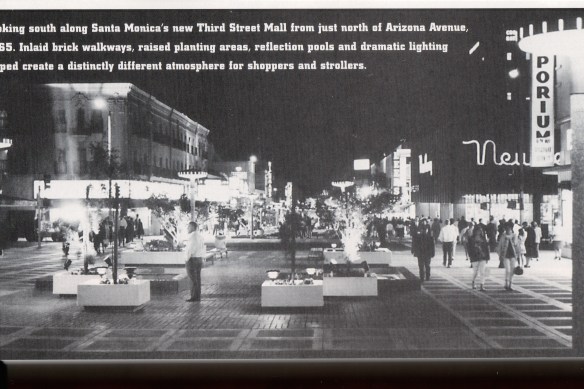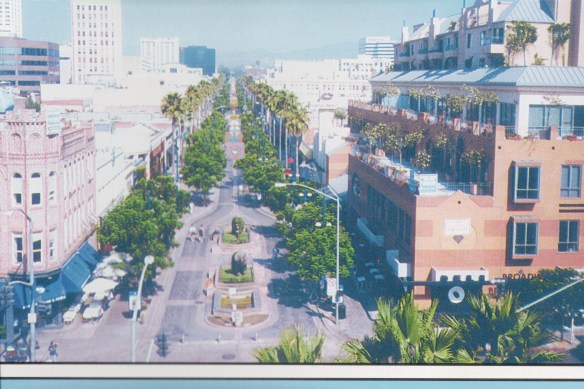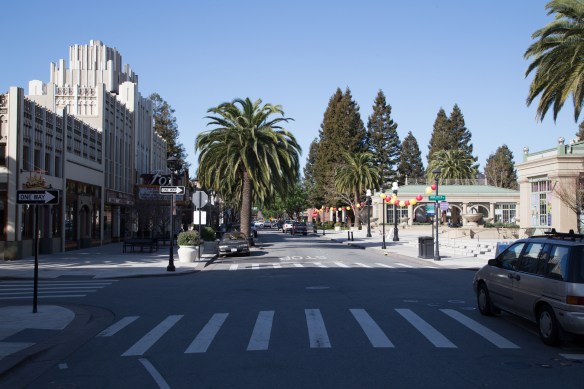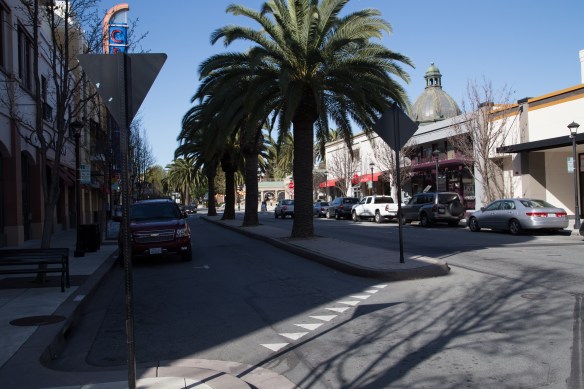Note: this article is just an idea I have for improving our downtown; as far as I know it is not something that is actually being considered at this time.
A couple of weeks ago I was talking to someone who was new to my blog, and he asked me why I created it and what I hoped to accomplish with it. In reply to the first part of his question I recited my story: how after a layoff I found myself missing my daily walk to and from Caltrain, and so I decided that—for exercise, if nothing else—I should continue walking. And how a friend, who enjoyed other blogs I had written about some of my cross-country Amtrak trips, suggested that I blog about what I saw while I was on my walks. As to the second part of the question, however—what do I hope to accomplish by writing this blog?—I simply replied that I hadn’t given it much thought (because I hadn’t), and that I didn’t really have any particular goal in mind.
Since then I’ve been doing a lot of thinking about the second part of his question. Although this blog started out being no more than my casual observations as I explore the four corners of Redwood City, very shortly I started taking it more seriously, doing research into what I was seeing in order to bring more depth to my posts. I generally try to stay neutral on most topics; I report what I see and let you draw your own conclusions. Sometimes, however, I cannot resist and do allow my opinions and biases to show through.
Over the past year or so the blog has become more professional (more like a job, in fact, although it does not yet pay) and more time consuming, and yet I still don’t really have a purpose. Or do I? In retrospect I think I had one almost from the very start, but never took the time to articulate it. So what do I hope to accomplish by writing this blog? Why, I want to do my part, in my own way, to make Redwood City an even better place to live and work. Redwood City has turned out to be an ideal place for my wife and I to live and raise our family, and I want to give back, not only by helping others to see what a great place it can be, but also by pointing out where it could use some improvement.
Which brings us to the subject of today’s post. I have spent more than 25 years walking around and driving through our downtown. My family and I have patronized many of Redwood City’s downtown restaurants and shops, watched many movies and plays in our downtown theaters, and enjoyed concerts, art fairs, and the like on closed-off downtown streets. These days, with so much change in the form of new buildings putting a strain on the character of our great downtown, I’ve been thinking about how it might be adjusted to better serve our needs and make us want to spend time there. A couple of years ago I had an idea for our downtown that I’ve been mulling over ever since, and I think that it is now time to haul it out into the light. Back in September I took a walk specifically with the intent of gathering supporting data for my idea and this article, and here, today, I present it to you.
So what is this grand idea? Just this: I propose that we close a downtown section of Broadway to vehicular traffic.
Whatever your first impression, stick with me for a bit and let me explain. I grew up on the west side of Los Angeles, and in 1964 several blocks of Santa Monica’s Third Street were closed off for this very purpose. The new “Third Street Mall” opened in 1965; it turned a street lined with shops that had lost customers to malls and shopping centers elsewhere, into a thriving outdoor mall:
(the above photo and the next are from the 1997 book Santa Monica Bay: Paradise by the Sea by Fred E. Basten) I have a lot of happy memories of the Third Street Mall from my younger days. In particular it had a “dollar theater” at which, on rainy Saturdays, my brothers and I watched many a family-friendly movie.
In the late 1980’s the mall was updated and rechristened, becoming the “Third Street Promenade”:
With theaters, restaurants, and popular shops, plus live entertainment (jugglers, musicians, etc.) out in what used to be the street, these days the Third Street Promenade is a place to be and be seen, particularly on balmy Southern California evenings. It is exactly the kind of place I envision that Broadway in downtown Redwood City could be, in fact.
Lets start by taking a look at Broadway between El Camino and (almost) Woodside Road. I’ve added the green line to the image from Apple’s Maps app to illustrate just how ruler-straight Broadway actually is:
Straight, that is, except for that one deviation where it approaches and then crosses the railroad tracks. Years ago Redwood City remodeled both the intersection and the small parklet that sits on the southwest side of the tracks, where the statue of Soledad de Arguello sits. The “Climate Best” arch was installed then (or was it simply moved and/or renovated? I can’t recall exactly) and I thought at the time that the city was going to straighten out Broadway and run it right beneath the arch. But that didn’t happen. At the time I believed that this was due primarily to the cost to rework Broadway where it crosses the tracks. Over time, however, I’ve come to believe that although cost was undoubtedly a factor, perhaps an even more important factor was a desire to route most traffic around our downtown rather than directly through the heart of it. This makes sense, actually: if you are trying to get from El Camino to the Woodside Rd/101 area, for instance, how does it benefit the city to have you barreling right throught the heart of the shopping and entertainment district? No, by shunting most of the traffic onto Marshall St., only those cars that truly need to be on pedestrian-heavy Broadway will end up going there.
Throughout each summer (and, because our weather is so good, throughout much of the rest of the year, too) we have numerous fairs and festivals downtown that necessitate closing some of our downtown streets. Perhaps the number one closure is the section of Broadway between Hamilton and Middlefield/Theatre Way. This is the section directly in front of the old courthouse; the section containing the Fox Theatre, Quinto Sol (on the Middlefield/Theatre Way end) and Le Boulanger (on the Hamilton St. end). Undoubtedly you, like me, have on occasion turned down Broadway only to find yourself facing barriers and large tents. You then have to detour around, taking a cross street to either to Marshall or Winslow. We’ve all learned the routine, however, and we seem to get along just fine when that part of Broadway is closed; there are plenty of alternatives. And thus, I think we should close it permanently.
Once we’ve taken the baby step of closing the Courthouse block, traffic coming down Broadway would have to detour around it. So cars might as well make that detour a little earlier, right? In fact, I’d suggest we close it all the way to the Caltrain tracks on the west side, to prevent people from turning off Marshall and then having to detour at all. On the east side, I’d ideally like to close it at Main (due to the large number of restaurants and shops between Jefferson and Main that would benefit from the increased pedestrian traffic), but would propose that we start by closing it at Jefferson and see how things go. Like this:
Here, I’ve marked the sections I propose we consider closing in red (with the optional bit between Jefferson and Main in blue). I’ll go through each block of Broadway shortly to identify some of the affected businesses, but note that I am only proposing that we close Broadway, and not any of the cross streets (although if we wanted to consider any of those, too, Theater Way in front of the Century Theaters would be my primary vote: I’ve never understood why that section was opened up to vehicular traffic when the theaters were built). No, as is the case with the Third Street Promenade, the pedestrian mall we would create running from Marshall to Jefferson (or Main) would be interrupted by cross streets with appropriate traffic controls (basically, the controls we have today, with the signals adjusted to account for Broadway being closed) to enable pedestrians to move between the blocks safely.
Two other things: for safety purposes removable bollards (short vertical posts) would be used to keep cars out while still allowing access for emergency vehicles. And I would suggest that we consider insetting the bollards such that a car can pull over, out of traffic, at each Broadway intersection to let passengers out. That way no one except the driver would have to walk more than half a block to get to any business on Broadway.
And we would gain an open-air mall, replete with new planters and benches, much like Stanford Mall. Restaurants with sidewalk seating, who today have to leave a pedestrian corridor, would be able to take up the entire sidewalk since pedestrains would be free to wander into the area where automobiles once roamed. And restaurant patrons sitting on the sidewalk would no longer have to endure the noise and fumes of the cars passing by right under their noses.
So what businesses are affected? Starting at Marshall Street and progressing from left to right using the above map as a guide, here is what is (or was, back in September) on each of the blocks:
Block 1: Marshall to Winslow
This is a nice block that includes a small “parklet” on the railroad side of the street where it curves. The block contains seven restaurants (note that I’m using the term “restaurant” to mean any food service establishment; anything from Kristie Marie’s or Bliss Coffee to Quinto Sol), a jewelry shop, a bank, an interior design shop (Brick Monkey), a PC repair business, the Fox Forum banquet hall, and, upstairs on the south side, a tech company. There are 5 parking spaces on each side of the street. Kristie Marie’s and Pamplemousse sit on corners where vehicular traffic would still have access. Two other restaurants (Sandwich Spot and Bliss Coffee) plus the bank and Brick Monkey sit in front of a parking lot, so access to those could be gained from the lot as well as the front.
Block 2: Winslow to Hamilton
On the north side there is a single business: the Chase Bank, with its own parking lot. On the south side, there are three restaurants (New Kapadokia has moved out, but I hope that another restaurant will take its place), plus a floral design shop, two hair salons, a jewelry shop, an accountancy business, and an interior furnishings shop. There appear to be a couple of tech business upstairs. We would lose a total of 10 street spaces on this block, five on each side.
Block 3: Hamilton to Middlefield/Theatre Way
On the north side is the old courthouse, with its museum, gift shop, and below-ground used bookstore (with a parking lot behind). There are four small businesses in the pavilions on the square (depending upon when you look; they seem to come and go) and no parking on this side of the street. The south side contains two restaurants, the Fox Theatre and Little Fox (and ticket office) plus some upstairs tech businesses. There are four street parking spaces here.
Block 4: Middlefield/Theatre Way to Jefferson
Almost there! On the north side of this block are two restaurants, the Dragon Theater, and a tech business (Shazam!) upstairs. On the south side there are two restaurants and a set of salons, with a real estate business (Sequoia Realty) upstairs. There are a total of 12 parking spaces on this block: eight on the north side and four against the theater building. This is a vary odd block, with an island between the two eastbound lanes of traffic; I have no idea what the traffic engineer was thinking when they designed this:
Optional Blocks: Jefferson to Main
Depending upon how you look at this, this is either one long block or two: the access to the Marshall Street garage and the entrance to the Main Street parking lot form an intersection with Broadway midway between Jefferson and Main. But both parking areas have access from other streets, so this mid-block intersection could conceivably be closed off.
Between Jefferson and Main there are quite a few restaurants of varying sizes, Powerhouse Gym (which really fronts onto Jefferson), the Arthur Murray and Studio S dance studios, plus various other small shops and salons. We would lose a total of 19 parking spaces if we closed off Broadway from Jefferson to Main.
By closing of sections of Broadway from Marshall to Jefferson, we would lose a total of 36 street parking spaces (55 if we closed all the way to Main) and the ability to park directly in front of some of the businesses that are there. But we will soon be gaining a huge amount of night and weekend parking in the nearby Crossing/900 buildings (far more than was there when that location was a surface parking lot), and how often do you find a space in front of the downtown business you are patronizing anyway? Benches and planters would turn the street into an inviting space where people would want to spend more time. Live entertainment and small vendors operating out of tents and wheeled carts would further add to the friendly, small-town atmosphere. And this all would serve to draw folks into closer proximity to our downtown shops, which would in turn attract more retailers to the area.
That’s what I would like to see in our downtown. How about you? Does this sound like it would work? Would you support such an idea? Are there tweaks that could make it even better? Give us your feedback in the comments, below.
Walking Redwood City is now on Twitter! Followers of @walkingRWC will not only get notified when I post new articles to the site, they will also get occasional short observations from me as I walk around the city. No worries if you aren’t on Twitter, though—I will continue to announce my posts using the existing mechanisms as well.








Pingback: Closing Steps | Walking Redwood City
Pingback: In Appreciation | Walking Redwood City
Pingback: Broadway Revue | Walking Redwood City
Pingback: Some Assembly Required | Walking Redwood City
I support this idea. I’d imagine the staggered approach is probably the most plausible. I could really see this concept gaining steam in a year or two once all the current residential condos/apartments are built out and filled. Lots of new people walking around downtown.
Great idea! We’re totally in support and happy to petition for it as well. If you do hear from city planners let us know. Good job with the blog as well.
Thanks!
I love the idea! You should meet with the fire chief and get some feedback to bolster the idea
Good idea. I’d be curious to get some feedback from a real urban planner and/or traffic engineer as well.
Seems an odd suggestion. Fire chiefs aren’t urban planners, often don’t live in communities they serve, and while they often oppose anything they think will add to response times, they are probably among the last people I’d expect to outright endorse (“bolster”) anything of the sort.
But closing streets does affect emergency response, which is very important. I’d certainly be interested in his opinion on how this idea might or might not affect their operation, especially with all the new buildings going up: they must have to plan ahead for these buildings as to where they’d drive and where they’d place their equipment in the event of an emergency in Crossing/900, say, or 201 Marshall. Not that either of these are on Broadway, of course, but they’re near. And a fire or medical emergency at the Fox, for instance, would mean that they might need to put equipment on a closed section of Broadway; I’d be interested in hearing their input on that. There are a lot of people who would need to weigh in on this idea; he is one of them, in my opinion. As is the City Planner, the traffic folks, the Downtown Merchants Association, the Parks Commission (assuming that they might be involved with the street amenities), etc.
Excellent idea … where do I sign up?
Oh, and first let’s see them close Theatre Way (“theater block” of Middlefield) between Winslow and Broadway. That’s long overdue.
They keep fiddling with the parking on Theatre Way, but with all the people crossing the street all throughout the block, I think the only logical, safe solution is to close it.
I thought I read somewhere in the past that the city already decided to close it during the busier periods (Fridays or on Summer nights? … I don’t recall the specifics) … I remember wondering why they were being so timid and not going for full and permanent closure. So maybe we’ll see it happen when Summer rolls around and/or the Box building (“Crossing 900“) is finished.
Great idea, Greg! And very persuasively presented. I just did some brief internet research, and there are many examples of pedestrian malls, including the Third Street Promenade, that have worked very well and revitalized an area. But there are also many examples that didn’t work and were reconverted to traffic. Even the Third Street Mall was originally considered a failure. So good design will be critical. But Broadway has many of the factors that lead to success, including the movie theatre, Fox Theatre, and lively entertainment on Courthouse Square. And it isn’t in a poor and depressed area. It’s also completely consistent with the emphasis by our city council and regional leaders on transit-oriented development.
Thanks!
Nice work! I really appreciate what you’re doing and know that there are others out there who care as well! -@croatianjeremy
Thanks!